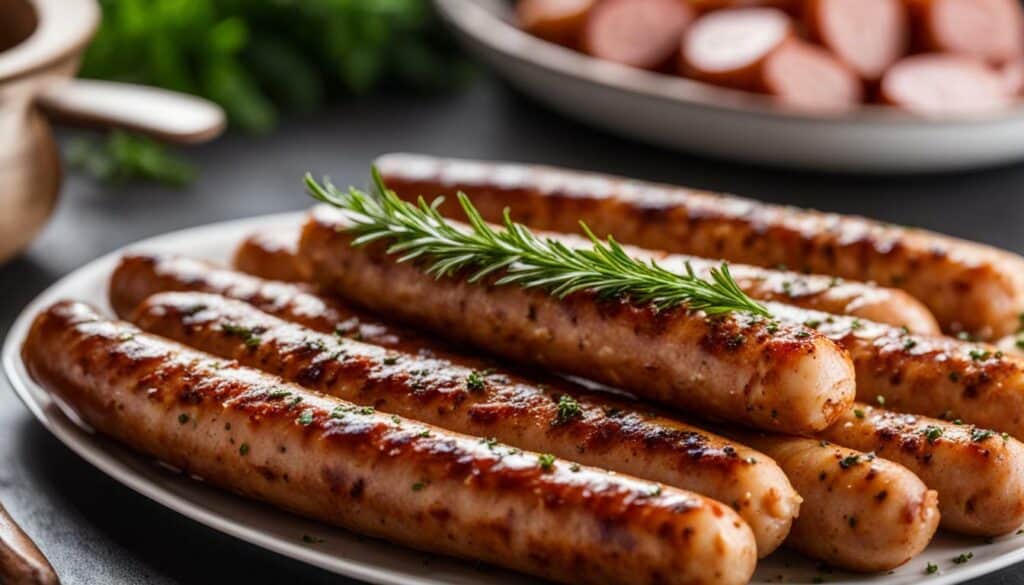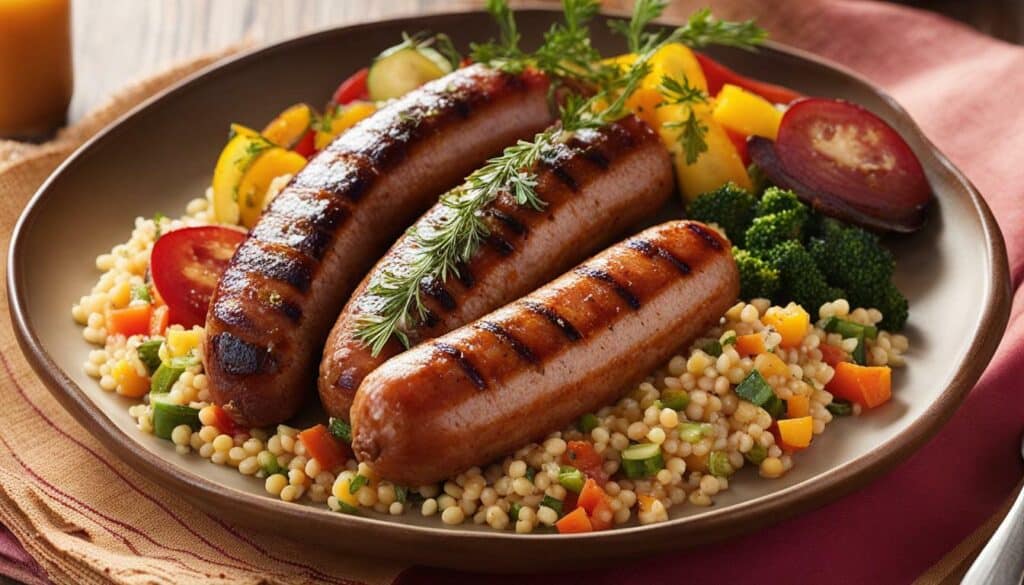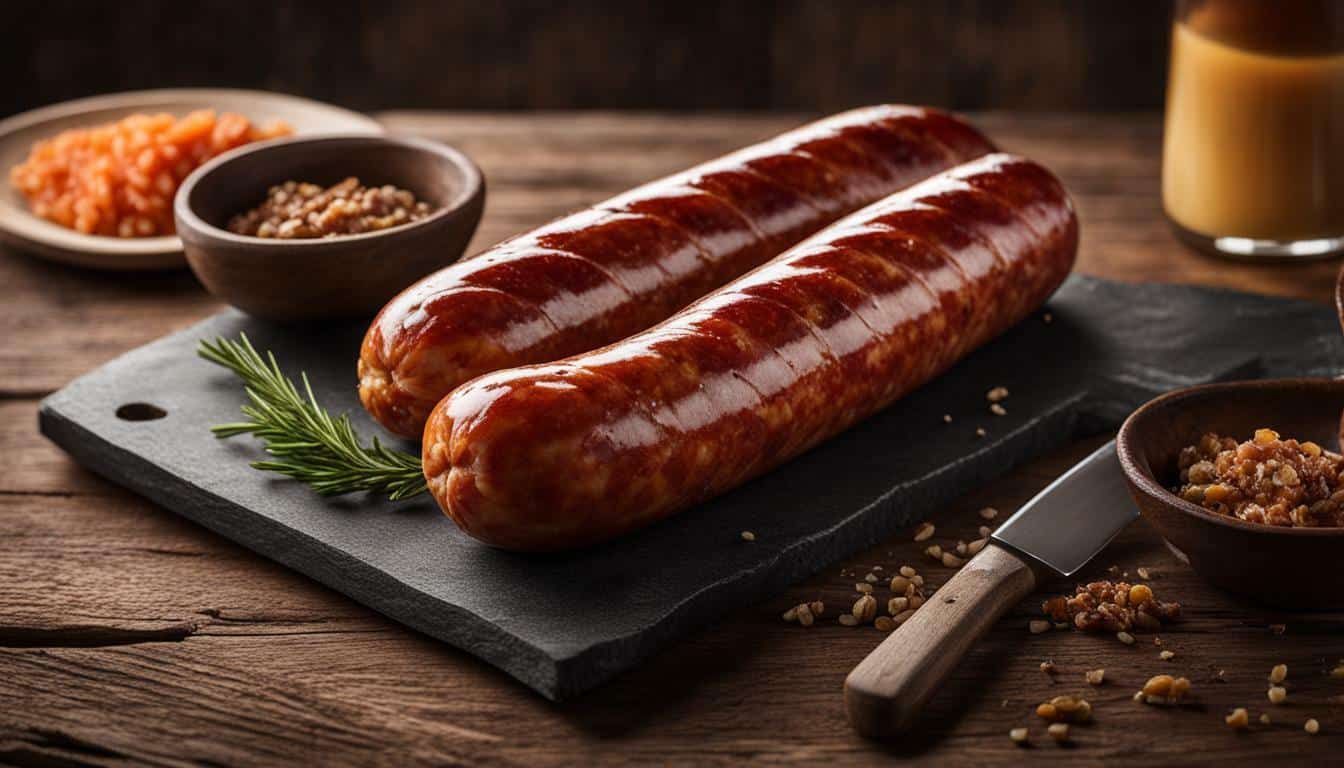Are you curious about the nutrition facts of sausage links and how they can impact your health journey? Let’s dive in and explore the truth behind this popular food choice. Sausage is a delicious and versatile option that can be found on breakfast plates, in comforting casseroles, and even on pizza. However, it’s important to understand the nutritional content of sausage to make informed dietary choices that support your overall well-being.
- Sausage is high in saturated fat and sodium, which can increase the risk of chronic diseases.
- Choosing leaner options like chicken or turkey sausage can reduce the fat content and make it a healthier choice.
- Sausage is a good source of protein and B vitamins, but it’s essential to consume it in moderation.
- Processed meats like sausage have been linked to an increased risk of cancer, heart disease, and diabetes.
- Paired with vegetables and whole grains, sausage can be part of a balanced meal.
By understanding the nutritional facts and making mindful choices, you can enjoy sausage as part of your health journey without compromising your overall well-being. Let’s explore further and uncover the truth behind sausage link nutrition facts!
The Impact of Sausage on Your Health
It’s crucial to be aware of how sausage can affect your health, as it is often high in saturated fat and sodium, which have been linked to an increased risk of chronic diseases. While sausage is undeniably tasty and a popular food choice for many households, it’s important to understand the potential impact it can have on your overall well-being.
Sausage contains high levels of saturated fat, which can contribute to the development of heart disease and raise cholesterol levels. A single serving of sausage can contain significant amounts of saturated fat, making it important to consider portion sizes and frequency of consumption. Additionally, sausage is often loaded with sodium, which can lead to high blood pressure and increase the risk of stroke.
According to the American Heart Association, a diet high in saturated fat and sodium can increase the risk of chronic diseases like obesity, type 2 diabetes, and cardiovascular disease. It’s essential to be mindful of your sausage intake and make informed choices about your overall dietary habits.
| Nutritional Content per Serving | Calories | Fat (g) | Cholesterol (mg) | Sodium (mg) |
|---|---|---|---|---|
| Italian Sausage | 258 | 20.5 | 42.8 | 557.3 |
While sausage may not be the healthiest choice, it does offer some nutritional benefits. Sausage is a good source of protein and B vitamins, which are essential for energy production and overall health. However, it’s important to note that there are leaner options available, such as chicken or turkey sausage, which can provide similar nutrients with less saturated fat and sodium.
Processed meats like sausage have been linked to an increased risk of cancer, heart disease, and diabetes. It’s recommended to limit the consumption of processed meats and opt for healthier alternatives whenever possible. Incorporating sausage into a balanced diet, paired with vegetables and whole grains, can help create a healthier meal that still satisfies your taste buds.
Choose leaner options and practice moderation
In conclusion, it’s crucial to be mindful of your sausage consumption and its impact on your health. While sausage can be enjoyed occasionally as part of a balanced diet, it’s important to choose leaner options, practice moderation, and be aware of its high levels of saturated fat and sodium. By making informed choices and incorporating healthier alternatives into your meals, you can still enjoy sausage while prioritizing your well-being.
Nutritional Content of Sausage Links
Let’s take a closer look at the nutritional breakdown of sausage links, focusing specifically on Italian sausage, which is a popular variety. It’s important to understand the nutritional content of sausages to make informed choices for your health journey.
| Nutrient | Amount per Serving |
|---|---|
| Calories | 258 |
| Fat | 20.5g |
| Cholesterol | 42.8mg |
| Sodium | 557.3mg |
Italian sausage contains 258 calories per serving. It is relatively high in fat, with 20.5 grams per serving, and cholesterol, with 42.8 milligrams per serving. Additionally, it is important to note that Italian sausage is also high in sodium, containing 557.3 milligrams per serving. These values may vary slightly depending on the specific brand and preparation method.
Despite the higher fat and sodium content, sausage can still provide some nutritional benefits. It is a good source of protein, which is essential for muscle growth and repair. Sausage also contains B vitamins, including thiamin, niacin, and vitamin B12, which are important for energy production and maintaining a healthy nervous system.

It is important to keep in mind that processed meats like sausage have been linked to an increased risk of chronic diseases, including cancer, heart disease, and diabetes. Therefore, it is recommended to consume sausage in moderation and choose leaner options, such as chicken or turkey sausage, whenever possible.
Incorporating sausage into a balanced diet can be done by pairing it with vegetables and whole grains to create a healthier meal. This can help increase the nutrient density of your dish and provide a more well-rounded nutritional profile.
Choose Leaner Options: Chicken and Turkey Sausage
When looking for healthier alternatives to traditional pork sausage, consider opting for chicken or turkey sausage. These leaner options typically have lower fat and sodium content compared to their pork counterparts. Additionally, they can provide a similar taste and texture, making it a suitable substitution in various recipes.
Remember, moderation is key when it comes to consuming sausage. Incorporate it as part of a balanced diet, focusing on whole foods and a variety of nutrients to support your overall health and well-being.
Sausage as a Source of Protein and B Vitamins
Did you know that sausage can actually be a good source of protein and essential B vitamins, such as thiamine, riboflavin, and niacin? While sausage often gets a bad reputation for its high fat and sodium content, it does have its nutritional benefits when consumed in moderation. Protein is an essential macronutrient that plays a crucial role in building and repairing tissues, as well as supporting the immune system. B vitamins, on the other hand, are important for energy production, brain function, and the formation of red blood cells.
When looking for a protein source, sausage can be an appealing option, especially for meat lovers. A serving of sausage can provide a decent amount of protein to help meet your daily requirements. Additionally, the B vitamins found in sausage play a vital role in maintaining overall health and well-being. Thiamine helps convert food into energy, riboflavin supports healthy vision and skin, and niacin aids in DNA repair and metabolism.
While sausage can offer these nutritional benefits, it’s important to make informed choices. Leaner options, such as chicken or turkey sausage, are lower in fat and can be healthier alternatives. To incorporate sausage into a balanced diet, consider pairing it with vegetables and whole grains to create a more nutrient-rich meal. This not only increases the fiber and vitamin content but also helps offset some of the higher fat and sodium levels typically found in sausage.
Table: Nutritional Content of Italian Sausage
| Nutrient | Amount per serving |
|---|---|
| Calories | 258 |
| Fat | 20.5g |
| Cholesterol | 42.8mg |
| Sodium | 557.3mg |

Remember, moderation is key when it comes to consuming sausage. While it can provide protein and B vitamins, processed meats like sausage have been linked to an increased risk of cancer, heart disease, and diabetes. Aim to limit your consumption of sausage and opt for leaner alternatives whenever possible. By making mindful choices and incorporating sausage into a well-balanced diet, you can enjoy its flavors while still prioritizing your health.
Choosing Leaner Sausage Options
If you still want to enjoy sausage as part of your diet, consider opting for leaner options like chicken or turkey sausage, which have lower fat content. These leaner alternatives can provide the flavors and satisfaction of traditional pork sausage while offering a healthier choice for your overall well-being.
Chicken sausage is an excellent option for those looking to reduce their fat intake. It is made from lean chicken meat, which is lower in saturated fat compared to pork sausage. A serving of chicken sausage contains approximately 150 calories, 7 grams of fat, and 18 grams of protein. With its lower calorie and fat content, chicken sausage can be a guilt-free addition to your meals.
Turkey sausage is another great lean option to consider. Made from lean turkey meat, it is lower in fat and calories than its pork counterpart. A serving of turkey sausage contains about 180 calories, 9 grams of fat, and 19 grams of protein. This makes it a nutritious choice for those who are watching their fat intake but still want to enjoy the flavors of sausage.
When incorporating leaner sausage options into your meals, consider pairing them with a variety of vegetables and whole grains. This combination will provide you with a balanced and nutritious meal that is rich in fiber, vitamins, and minerals. Whether you’re adding chicken or turkey sausage to pasta dishes, stir-fries, or breakfast scrambles, the possibilities are endless.
Remember, moderation is key. While leaner sausage options can be a healthier choice, it’s important to consume them in moderation as part of a well-rounded diet. By making informed choices and balancing your sausage intake with other nutritious foods, you can continue to enjoy the flavors of sausage on your health journey.
Unfortunately, processed meats like sausage have been linked to a higher risk of developing serious health conditions, including cancer, heart disease, and diabetes. These risks arise due to the high levels of sodium, saturated fat, and preservatives found in processed meats. According to research, consuming just 50 grams of processed meat daily, which is equivalent to about two slices of bacon or one sausage, can increase the risk of colorectal cancer by 18%. This is a significant finding that highlights the need for moderation when it comes to consuming sausage and other processed meats.
Processed meats are often made from lower-quality cuts of meat, and they undergo various curing, smoking, and preserving processes. These methods can result in the formation of harmful compounds such as nitrosamines and polycyclic aromatic hydrocarbons (PAHs), which are known to be carcinogenic. Additionally, the high sodium content in processed meats can contribute to hypertension and increase the risk of heart disease and stroke.
Research has shown that the consumption of processed meats is associated with a higher risk of developing cancer. The World Health Organization (WHO) has classified processed meats as Group 1 carcinogens, which means that there is sufficient evidence to prove their link to cancer.
It’s important to note that while processed meats like sausage have been associated with health risks, it does not mean that you have to completely eliminate them from your diet. It’s all about balance and moderation. Enjoying sausage occasionally as part of a well-rounded diet that includes plenty of fruits, vegetables, whole grains, and lean proteins can still be compatible with a healthy lifestyle.

| Nutritional Content per serving of Italian Sausage: | Calories | Fat (g) | Cholesterol (mg) | Sodium (mg) |
|---|---|---|---|---|
| Typical Serving | 258 | 20.5 | 42.8 | 557.3 |
Summary:
- Processed meats like sausage are linked to an increased risk of cancer, heart disease, and diabetes.
- High levels of sodium, saturated fat, and preservatives in processed meats contribute to these health risks.
- Consuming just 50 grams of processed meat daily can increase the risk of colorectal cancer by 18%.
- Processed meats contain harmful compounds such as nitrosamines and PAHs, which are known carcinogens.
- Enjoying sausage occasionally as part of a balanced diet is still possible, but moderation is key.
Moderation and Balanced Consumption
Like many foods, sausage can still have a place in your diet if consumed in moderation and as part of a balanced eating plan. While sausage is high in saturated fat and sodium, it can still provide nutritional benefits when enjoyed in appropriate amounts. To ensure that you are incorporating sausage into a healthy diet, here are some guidelines to follow:
- Limit consumption: It’s important to enjoy sausage in moderation. Consider having it as an occasional treat rather than a daily indulgence.
- Choose leaner options: Opt for chicken or turkey sausage, which are lower in fat. This can help reduce the overall saturated fat content of your meal.
- Pair with vegetables and whole grains: By adding a variety of vegetables and whole grains to your sausage-based meals, you can increase the nutritional value and create a more balanced dish. Try sautéing vegetables like bell peppers, onions, and zucchini to accompany your sausage, or serve it over a bed of whole grain pasta or quinoa.
- Monitor portion sizes: Be mindful of the portion sizes when enjoying sausage. Stick to recommended serving sizes to avoid consuming excess calories, fat, and sodium.
- Explore alternative cooking methods: Instead of frying sausage in oil, consider grilling, baking, or broiling it. These cooking methods can help reduce the amount of added fat while still providing a flavorful and satisfying meal.
By following these tips, you can enjoy sausage as part of a balanced diet without compromising your health. Remember, moderation is key, and it’s important to listen to your body’s needs and make informed choices when it comes to your dietary habits.
Table: Nutritional Content of Italian Sausage
| Nutrient | Amount per Serving |
|---|---|
| Calories | 258 |
| Total Fat | 20.5g |
| Cholesterol | 42.8mg |
| Sodium | 557.3mg |
By being mindful of your sausage consumption and making balanced choices, you can still incorporate this savory food into your diet without compromising your health goals. Remember to savor sausage in moderation and pair it with nutrient-rich ingredients to create delicious and satisfying meals.

To make your sausage meals healthier, consider pairing them with a variety of vegetables and incorporating whole grains to provide a more balanced and nutritious plate. Vegetables like bell peppers, onions, and zucchini can add a burst of flavor and vibrant colors to your sausage dish. Saute them alongside the sausage for a delicious combination. Add some leafy greens like spinach or kale to boost your meal’s nutritional value.
Whole grains are another great addition to your sausage meals. Opt for whole wheat buns or bread when making sausage sandwiches. You can also substitute traditional pasta with whole wheat or whole grain pasta for a more nutritious option. Brown rice or quinoa can be served alongside sausage as a wholesome side dish.
When it comes to cooking sausage, try grilling or baking instead of frying. This reduces the amount of added fat and calories in your meal. To enhance the flavors, season your sausage with herbs and spices instead of relying on high-sodium condiments. Fresh herbs like rosemary, thyme, or basil can add a burst of freshness to your dish.
| Sausage Pairings | Healthy Cooking Tips |
|---|---|
| Grilled sausage with roasted vegetables | Use leaner sausage options like chicken or turkey |
| Sausage stir-fry with bell peppers and broccoli | Bake or grill instead of frying to reduce added fat |
| Sausage and whole wheat pasta with marinara sauce | Season sausage with herbs for added flavor |
| Sausage and quinoa stuffed bell peppers | Pair sausage with colorful vegetables and whole grains |
Remember, moderation is key. Enjoy sausage as part of a balanced diet, alongside a variety of other nutritious foods. By making thoughtful choices in your pairings and cooking methods, you can still savor the flavors of sausage while prioritizing your health.

If you’re looking for even healthier alternatives to traditional pork sausage, give chicken and turkey sausage a try – they offer a leaner option without compromising on flavor. Chicken and turkey sausages are made from leaner meats, which means they have lower fat content compared to pork sausages. This makes them a great choice for those who are conscious of their saturated fat intake. They are also lower in calories, making them a better option for those looking to maintain a healthy weight.
Not only are chicken and turkey sausages lower in fat, but they also offer similar nutritional benefits. They are a good source of protein, which is essential for building and repairing tissues in the body. Protein is also important for maintaining a healthy immune system. Chicken and turkey sausages are also rich in B vitamins, such as niacin and vitamin B6, which play a vital role in energy production and brain function.
When it comes to cooking with chicken and turkey sausages, the possibilities are endless. You can grill them, sauté them, or even use them in stir-fries and pasta dishes. They pair well with a variety of vegetables, such as peppers, onions, and zucchini, adding both flavor and nutrition to your meals. For a complete meal, serve them with whole grains like quinoa or brown rice to increase the fiber content and create a well-balanced plate.
| Nutritional Content | Chicken Sausage (per serving) | Turkey Sausage (per serving) |
|---|---|---|
| Calories | 140 | 180 |
| Total Fat (g) | 6 | 8 |
| Cholesterol (mg) | 45 | 60 |
| Sodium (mg) | 450 | 550 |
Chicken Sausage vs Turkey Sausage
- Chicken sausage tends to be lower in calories and fat compared to turkey sausage.
- Turkey sausage may have a slightly higher cholesterol and sodium content than chicken sausage.
If you’re looking to cut back on saturated fat and calories while still enjoying the delicious taste of sausage, consider adding chicken or turkey sausage to your grocery list. It’s a healthier alternative that doesn’t compromise on flavor and provides you with essential nutrients. Remember, moderation and balance are key when it comes to incorporating sausage into a healthy diet.

Remember, when it comes to sausage, moderation is key – incorporating it into a balanced diet alongside other nutritious foods is essential for maintaining optimal health. Sausage is a popular food choice for many households, but it’s important to be aware of its nutrition facts for your health journey.
Sausage is high in saturated fat and sodium, which can increase the risk of chronic diseases such as heart disease and diabetes. However, if consumed occasionally and in moderation, sausage can still be part of a healthy diet. It’s all about finding the right balance.

The nutritional content of sausage varies depending on the type. For example, a serving of Italian sausage contains approximately 258 calories, 20.5g of fat, 42.8mg of cholesterol, and 557.3mg of sodium. It’s important to be mindful of these numbers when incorporating sausage into your meal plans.
While sausage may not be the healthiest protein option, it can still provide valuable nutrients such as protein and B vitamins. To make a healthier choice, opt for leaner options like chicken or turkey sausage, which are lower in fat but still offer the same great taste. This way, you can enjoy the flavors of sausage while also making a healthier choice for your body.
Processed meats like sausage are linked to an increased risk of cancer, heart disease, and diabetes. Therefore, it’s recommended to limit consumption and choose alternative protein sources whenever possible. Remember, moderation is key.
When cooking with sausage, consider healthier pairings such as incorporating vegetables and whole grains into your meals. This not only adds nutritional value but also creates a more balanced dish. Don’t be afraid to experiment with different flavors and ingredients to make your sausage meals more nutritious and delicious.
Overall, sausage should be consumed in moderation and as part of a balanced diet for optimal health. By being mindful of its nutrition facts, choosing leaner options, and incorporating it into a well-rounded meal plan, you can continue to enjoy sausage while also taking care of your health.
Conclusion
By uncovering the nutrition facts of sausage links, we can make informed choices that support our health journey and ensure a balanced approach to our diet.
Sausage is a popular food choice for many households, but it’s important to be aware of its nutrition facts for your health journey. Sausage is high in saturated fat and sodium, which can increase the risk of chronic diseases. However, if consumed occasionally and in moderation, sausage can still be part of a healthy diet.
The nutritional content of sausage varies depending on the type, with Italian sausage containing 258 calories, 20.5g of fat, 42.8mg of cholesterol, and 557.3mg of sodium per serving. Sausage is a good source of protein and B vitamins, but it’s important to choose leaner options such as chicken or turkey sausage.
Processed meats like sausage are linked to an increased risk of cancer, heart disease, and diabetes, so it’s recommended to limit consumption. Sausage can be paired with vegetables and whole grains to make a healthier meal, and there are also leaner options available such as chicken or turkey sausage. Overall, sausage should be consumed in moderation and as part of a balanced diet for optimal health.
FAQ
Q: Is sausage healthy?
A: Sausage can be part of a healthy diet if consumed occasionally and in moderation. However, it is high in saturated fat and sodium, which can increase the risk of chronic diseases. Choosing leaner options like chicken or turkey sausage is recommended.
Q: What are the nutritional facts of Italian sausage?
A: A serving of Italian sausage contains approximately 258 calories, 20.5g of fat, 42.8mg of cholesterol, and 557.3mg of sodium. It is important to be aware of these nutritional facts when incorporating Italian sausage into your meals.
Q: Does sausage provide any nutritional benefits?
A: Yes, sausage is a good source of protein and B vitamins. However, it is important to balance its consumption with other healthier food choices and opt for leaner options to minimize the negative effects of its high saturated fat and sodium content.
Q: Are there healthier alternatives to traditional sausage?
A: Yes, chicken and turkey sausage are leaner alternatives to traditional pork sausage. They contain less fat and can be a healthier option for those looking to reduce their saturated fat intake.
Q: Are there any health risks associated with consuming sausage?
A: Processed meats like sausage have been linked to an increased risk of cancer, heart disease, and diabetes. It is important to limit consumption and make informed dietary choices to minimize these risks.
Q: How should sausage be incorporated into a balanced diet?
A: Sausage can be paired with vegetables and whole grains to create a healthier meal. It is important to consume sausage in moderation and balance its intake with other nutritious food choices for overall health and well-being.
Q: What are some healthy pairings and cooking tips for sausage?
A: To make a healthier meal with sausage, consider pairing it with vegetables and whole grains. Grilling or baking sausage instead of frying can also help reduce the calorie and fat content of the dish.
Q: Are there any leaner options available for sausage?
A: Yes, chicken and turkey sausage are leaner options compared to traditional pork sausage. They offer similar flavors and can be a healthier choice for those watching their fat intake.
Q: What is the key to consuming sausage in a healthy way?
A: The key to consuming sausage in a healthy way is moderation. It should be enjoyed occasionally and in balanced portions, along with other wholesome food choices, to support a healthy lifestyle.
Is Pacific Catch a Healthy Option Compared to Sausage Links?
When it comes to making healthier food choices, it is crucial to uncover pacific catch nutrition information before comparing it to sausage links. Understanding the nutritional value of each option can help individuals make informed decisions about their dietary preferences and wellness goals.





Leave a Reply